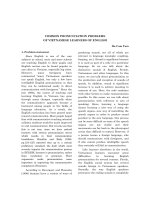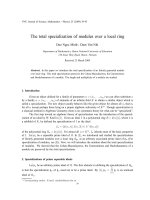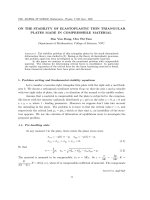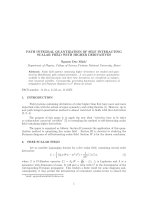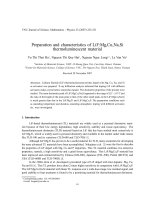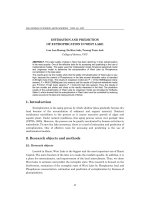Tài liệu Báo cáo " PATH INTEGRAL QUANTIZATION OF SELF INTERACTING SCALAR FIELD WITH HIGHER DERIVATIVES " pdf
Bạn đang xem bản rút gọn của tài liệu. Xem và tải ngay bản đầy đủ của tài liệu tại đây (80.65 KB, 5 trang )
PATH INTEGRAL QUANTIZATION OF SELF INTERACTING
SCALAR FIELD WITH HIGHER DERIVATIVES
Nguyen Duc Minh
1
Department of Physics, College of Science,Vietnam National University, Hanoi
Abstract: Scalar field systems containing higher derivatives are studied and quan-
tized by Hamiltonian path integral formalism. A new point to previous quantization
methods is that field functions and their time derivatives are considered as indepen-
dent canonical variables. Consequen tly, generating functional, explicit expressions of
propagators and Feynman diagrams in φ
3
theory are found.
PACS number: 11.10 z, 11.55 m, 11.10.Ef.
1. INTRODUCTION
Field systems containing derivatives of order higher than first have more and m ore
important roles with the advent of super-symmetry and string theories [1]. However, up to
now path integral quantization method is almost restricted to fields with fir s t derivatives
[2, 3, 4].
The purpose of this p aper is to apply the new ideal “velocities have to be taken
as independent canonical variables” [5] to extending the method to self-interacting scalar
field containing higher derivatives.
The paper is organized as follows: Section II presents the application of this quan-
tization method to quantizing free scalar field . Section III is devoted to studying the
Feynman diagrams of self-interacting scalar field. Section IV is for th e drawn conclusion.
2. FREE SCALAR FIELD
Let us consider Lagrangian density for a free scalar field, containing second order
derivatives
L =
1
2
∂
µ
φ ∂
µ
φ − m
2
φ
2
+
1
2Λ
2
φ φ, (1)
where is D’Alamber operator ( = ∂
µ
∂
µ
=
∂
2
∂t
2
− △), △ is Laplacian and Λ is a
parameter with dimension of mass. It will give a term with k
4
in the denominator of the
corresponding Feynman propagator. This renders a finite result for some diagrams and,
consequently, it may permit the introduction of convenient counter-terms to absorb the
1
email: nguyenducminh3
1
2 Nguyen Duc Minh
infinities which will appear when the limit Λ is taken.
The canonical momenta, conjugate to φ and
˙
φ, are respectively
π =
˙
φ −
1
Λ
2
˙
φ ; s =
1
Λ
2
φ. (2)
Now, there are no constraints involved. We notice that
˙
φ is n ow an independent canonical
variable and then it has to be functionally integrated. Thus, the canonical Hamiltonian
density becomes
H
c
= π
˙
φ + s
¨
φ − L
= πX +
1
2
Λ
2
s
2
+ s ∇
2
φ −
1
2
X
2
+
1
2
(∇φ)
2
+
1
2
m
2
φ
2
,
(3)
where to avoid mistakes we have denoted th e independent coordinate
˙
φ by X.
The corresponding generating functional is given by
Z [J, K] = N
[dφ] [ds] [dπ] [dX] exp
i
d
4
x
π
˙
φ + s
˙
X − πX −
− s∇
2
φ +
1
2
X
2
−
1
2
(∇φ)
2
−
1
2
m
2
φ
2
+ J φ + KX
.
(4)
In this case, integrations over π and X are immediately calculated by using delta func-
tionals and 4-dimensional Gaussian integral. Integration over φ is calculated by putting
φ = φ
c
+ψ, in which, φ
c
is determined by field equation for extended Lagrangian, it means,
satisfying
m
2
+ −
1
2Λ
2
= J −
˙
K. (5)
The result is
Z [J, K] = N
1
exp
i
2
d
4
x
J (x)
1
+ m
2
−
1
Λ
2
J (x)
− K (x)
∂
2
0
+ m
2
−
1
Λ
2
K (x)
+2K (x)
∂
0
+ m
2
−
1
Λ
2
J (x)
.
(6)
The Feynman propagator 0| T (φ (x) φ (x
′
)) |0 can be directly obtained by the usual
expression
0| T
φ (x) φ
x
′
|0 =
i
−2
Z
δ
2
Z
δJ (x) δJ (x
′
)
J,K=0
= −
i
m
2
+ −
1
Λ
2
δ
4
x − x
′
.
(7)
Path Integral Quantization Of Self-Interacting Scalar Field With Higher Derivatives 3
Since we have introduced a source for
˙
φ, it is also possible to calculate the followin g
propagators
0| T
˙
φ (x)
˙
φ
x
′
|0 =
i ∂
2
0
m
2
+ −
1
Λ
2
δ
4
x − x
′
, (8)
0| T
φ (x)
˙
φ
x
′
|0 =
−i ∂
0
m
2
+ −
1
Λ
2
δ
4
x − x
′
. (9)
Propagator (7) is in agreement with the correct propagator by following the usual
canonical procedu re [6]. More over, when the limit Λ is taken, it has the usual form cor-
responding to the ordinary free scalar field (containing first derivatives) we have known
before. The above propagators calculated explicitly is an important step to obtain Feyn-
man diagrams and propagators of self-interacting scalar field in the next section.
3. SCALAR FIELD IN φ
3
THEORY
Now, we consider φ
3
self-interacting scalar field by adding an interacting term
L
int
= −
g
6
φ
3
to the Lagrangian (1)
L =
1
2
∂
µ
φ ∂
µ
φ − m
2
φ
2
+
1
2Λ
2
φ φ +
g
6
φ
3
. (10)
Since the interacting field L
int
only depends on φ and the final form of the generating
functional Z contains only field configuration dφ un der the integrand, the generating func-
tional Z [J, K] with higher derivatives, in φ
3
interacting theory, is similar to the ones with
first order derivatives. I t means, the re-normalization generating functional [7] Z [J, K] is
Z [J, K] =
exp
i
L
int
1
i
δ
δJ
dx
Z
0
[J, K]
exp
i
L
int
1
i
δ
δJ
dx
Z
0
[J, K]
J,K=0
. (11)
Since L
int
also depends on φ, the formula of the S matrix still has form
S =: exp
φ
int
K
δ
δJ (z)
: Z [J, K]|
J,K=0
, (12)
where K = + m
2
−
1
Λ
2
.
So that, we can apply LSZ formula to the interaction between two in-p articles and
two out-particles. The scattering amplitude is
f |S − 1| i =
d
4
x
1
d
4
x
2
d
4
x
′
1
d
4
x
′
2
e
i
(
k
1
x
1
+k
2
x
2
−k
′
1
x
′
1
−k
′
2
x
′
2
)
K (x
1
) K (x
2
) ×
× K
x
′
1
K
x
′
2
0| T
φ(x
1
)φ (x
2
) φ
x
′
1
φ
x
′
2
|0
C
,
(13)
where K (x
1
) τ (x
1
, y) = −i δ
4
(x
1
− y).
Formula (13) is calculated explicitly through 4-point function (the procedure is the
same as in [7])
f |S − 1| i = (−ig)
2
d
4
y d
4
z τ (y − z)
e
i
(
k
1
y +k
2
y −k
′
1
z−k
′
2
z
)
+ e
i
(
k
1
y +k
2
z−k
′
1
y −k
′
2
z
)
+ e
i
(
k
1
y +k
2
z−k
′
1
z−k
′
2
y
)
+ O
g
4
,
(14)
4 Nguyen Duc Minh
where
τ (x − y) =
d
4
k
(2π)
−i
k
2
− m
2
+ iε +
1
Λ
2
k
4
e
ik(x−y)
. (15)
Substituting (15) into (14) and integrating over dy dz, we obtain
f| S − 1 |i = ig
2
(2π)
4
δ(k
1
+ k
2
− k
′
1
− k
′
2
)
×
1
(k
1
+ k
2
)
2
− m
2
+
1
Λ
2
(k
1
+ k
2
)
4
+
1
(k
1
− k
′
1
)
2
− m
2
+
1
Λ
2
(k
1
− k
′
1
)
4
+
1
(k
1
− k
′
2
)
2
− m
2
+
1
Λ
2
(k
1
− k
′
2
)
4
+ O(g
4
).
(16)
From (16), we have the following Feynman rules for the scattering amplitude
Diagrammatic representation Factor in S matrix
Internal line
k
−i
k
2
−m
2
+iε+
1
Λ
2
k
4
External line 1
Vertex
−i
k
2
−m
2
+iε+
1
Λ
2
k
4
In summary, by using above improved path integral quantization method, Feynman
diagrams for self-interacting φ
3
scalar field are foun d. In general, when interacting term
is more complicated, for example it contains derivatives of φ, Feynman diagrams will have
two more new kinds of vertex, corresponding to interacting vertices
˙
φ − φ and
˙
φ −
˙
φ.
4. CONCLUSION
We have studied the Hamiltonian path integral formulation for scalar field with
higher derivatives and also considered th e system in φ
3
self-interaction. The new ideal is
that time derivatives of field functions are considered as independent canonical variables.
Generating functional and explicit expressions of pr op agators are calculated. Feynman
diagrams for φ
3
interacting field are obtained explicitly. Extension of this result to elec-
trodynamics (interacting with matter), string theory or gravity theory will be studied
latter.
Path Integral Quantization Of Self-Interacting Scalar Field With Higher Derivatives 5
ACKNOWLEDGMENT
The author would like to thank Prof. Nguyen Suan Han for his suggestions of the
problem and many useful comments.
REFERENCES
1. J. Barcelos-Neto and N.R.F. Braga, Phys. Rev. D39, (1989) 494.
2. R.P. Feynman, Rev. Mod. Phys. 20, (1948) 367.
3. P. Senjanovic, Ann. Phys. 100, (1976) 227 .
4. G.A. Vilkovisky, Phys. Lett. 55B, (1975) 224; I.A. Batalin and G. Vilkovisky, Phys.
Lett. 69B, (1977) 309; E.S. Fradkin and T.E. Fradkina, Phys. Lett. 72B, (1978) 343.
5. J. Barcelos-Neto and C.P. Natividade, preprint, Hamiltonian path integral formalism
with higher derivatives, IF-UFRJ 24/90.
6. J. Barcelos-Neto and N.R.F. Braga, Mod. Phy s . Lett. A4, (1948) 2195.
7. H. Ryder, Quantum field theory, second edition, Cambridge university press (1996).
8. A.A. Slavnov, Theor. Math. Phys. 13, (1972) 1064.

